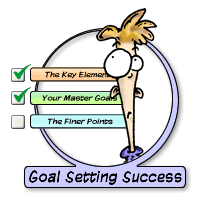 We all have the same 24 hours in a day and the same 7 days in a week. So why is it that some top producers seem to get mountains of things accomplished while others seem to never move closer to their goals?
We all have the same 24 hours in a day and the same 7 days in a week. So why is it that some top producers seem to get mountains of things accomplished while others seem to never move closer to their goals?
Well, first I’d suggest that those high achievers have a clear picture of what they are trying to get done.
Secondly, I’d say that they value their time more than most and make sure that they are getting a significant return on the time they invest in activities.
And finally I believe that they successful plan their day to make sure they move closer to their goals.
While this isn’t specifically a goal achievement program, I strongly suggest that you spend some time deciding exactly how you want your business to look in 6, 12, 24 and 36 months. Once you have that clear picture of your future, then making decisions on how to spend your time becomes much easier. It essentially boils down to this:
 If the activity is going to move you closer to your goals, then you should do it. If it’s going to move you farther away, then don’t do it.
If the activity is going to move you closer to your goals, then you should do it. If it’s going to move you farther away, then don’t do it.
As you evolve in your business endeavors you’re choices on activities will often be:
But you need to know what your goals are. Do you?
Once you’ve decided what your goals are, achieving them becomes easier.
You essentially need to find the fastest and most direct route to the goals that you want to achieve.
This seems pretty simple, right?
Then why don’t most people live their lives this way?
 Well, most of us are bombarded with so many distractions every day that the direct route is no longer obvious. So much of our attention gets diverted and so many people promise us the quick fix that keeps us on the right path that we’re usually prevented from achieving our goals.
Well, most of us are bombarded with so many distractions every day that the direct route is no longer obvious. So much of our attention gets diverted and so many people promise us the quick fix that keeps us on the right path that we’re usually prevented from achieving our goals.
The other problem is that we see the latest ‘fad’ and soon have a different goal that takes all of our focus away from our initial goal.
 So here’s what I suggest that you do: Get very clear on what you want. Once you’re clear, work backward from where you want to be to where you are. If you are not sure of the steps in between, the easiest was to develop a path to follow is to model someone who’s achieved what you want to achieve. Learn the steps that they took and build them in to your plan.
So here’s what I suggest that you do: Get very clear on what you want. Once you’re clear, work backward from where you want to be to where you are. If you are not sure of the steps in between, the easiest was to develop a path to follow is to model someone who’s achieved what you want to achieve. Learn the steps that they took and build them in to your plan.
The approach that I’ve had the most success in using backward planning is to set 3 types of goals:
The short term goals all lead to the medium term goals and the medium term goals lead to the long term goals. Everything is interconnected.
With this approach daily planning becomes simple. I need to perform activities that move me closer to my short term goals. If they don’t move me closer to those goals I need to try to eliminate those activities.
So here exactly how I suggest that you do your daily planning:
On Sunday identify the tasks that you need to accomplish during the upcoming week to keep you on track to achieve you short term goals.
 Each night spend 10 minutes planning the upcoming day. This will allow you to ‘sleep easy’ knowing that you are going to accomplish what you need to. Make sure that you have at least one ‘core task’ that no matter what, you will get accomplished in the upcoming day that will move you toward your goal. At the same time you should evaluate what you were able to accomplish during the day that’s coming to a close and whether the decisions you made moved you closer to your goals or took you farther away.
Each night spend 10 minutes planning the upcoming day. This will allow you to ‘sleep easy’ knowing that you are going to accomplish what you need to. Make sure that you have at least one ‘core task’ that no matter what, you will get accomplished in the upcoming day that will move you toward your goal. At the same time you should evaluate what you were able to accomplish during the day that’s coming to a close and whether the decisions you made moved you closer to your goals or took you farther away.
In the morning review your task list for the day. Allocate all your energies to accomplishing at least one ‘core’ task that will move you closer to your short term goal. If you’re booked with clients or designing programs all morning, get up a bit earlier or block off 30 minutes to make sure that you can accomplish a high return activity.
Review your goals and task list at least once during the day to make sure that you stay on track. By reviewing your goals too (and not just your tasks) you’ll be more likely to stay motivated.
A few tips to make sure that you get the most from your planning:
![]() Accept the fact that you’re not going to get everything that you want to done each day. That’s not an excuse so you don’t do anything.
Accept the fact that you’re not going to get everything that you want to done each day. That’s not an excuse so you don’t do anything.
Pledge to accomplish at least one task that moves you closer to your goals each day. Small, incremental improvements add up quickly.
Recognize that all actions move you closer to or farther from your goals. Make note each evening of the activities that are moving you farther from your goals and track to see if patterns become apparent. If you’re spending 2 hours a day on e-mail but don’t have time to market, then you’ve seen a pattern that you need to change.
By Pat “Good Ole’ Boy” Rigsby of www.FitnessBusinessInsider.com



Another bit of great information in such a simplistic format. Thanks again Pat for keeping it real!
That was awesome Pat. I really appreciate adding value to Super-Trainer. I also appreciate not being scarcity minded and welcoming me to the fitness marketing arena.